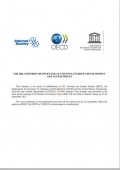Report from the Internet Society, the Organisation for Economic Co-operation and Development (OECD) and the United Nations Educational, Scientific and Cultural Organization (UNESCO)
Main Findings and Conclusions
1. Societies have a rich heritage and knowledge base that should be recognised, recorded and shared for the benefit of people throughout the world. Much of the world’s content remains inaccessible even to the local population, not to mention at a broader level. There are many reasons for the existence of this “content divide”.
2. The content that is most important to people is typically in their own language and is relevant to the communities in which they live and work. These communities may be defined by their location, culture, language, religion, ethnicity or area of interest and individuals may belong to many communities at the same time. Further, communities evolve so what is relevant will change over time. This relevant content is often referred to as “local content”. The term community is used in a broad way to include not only local professional communities (public and private), but also non-professional content creators and users.
3. Technology can help support the recognition, creation, preservation, dissemination and utilisation of local content and there have been several important technological advancements in recent history. Technological developments such as the printing press, the phonogram, telephony, radio, television, photocopying machines, recording media, mobile phones and personal computers, among others, have greatly increased our ability to create and disseminate content.
4. The Internet represents another historical advancement in the development and dissemination of content. It has, first and foremost, helped empower users as content creators. The Internet has provided a platform for crowd-sourced content creation and community-developed and peer-reviewed knowledge bases such as Wikipedia. It has also allowed individuals to exercise greater choice and control over the content they consume, in contrast to the limited channels of traditional broadcasting. It plays a key role in all steps from content creation to its distribution but perhaps its largest contribution is the potential it gives to creators to disseminate information their content widely and nearly instantaneously at a very low cost.
5. Policy makers around the world in ministries of culture look for ways promote the creation and preservation of cultural heritage, including element that are tangible, oral and intangible. At the same time, policy makers in communication ministries focus on ways to ensure that information and communication technologies and services, such as Internet access, are available and accessible to the population. This research confirms that the goals of these two important government entities are intertwined.
6. This empirical research shows there is a strong correlation between the development of network infrastructure and the growth of local content, even after controlling for economic and demographic factors. The statistically significant relationship is evident using several different measures of local content (the number of visible top-level domains in use per country code, per capita; Wikipedia articles per language per capita; and blogs per capita) and several measures of Internet development (broadband penetration rates, autonomous systems per capita, international bandwidth per capita and routed IPv4 addresses per capita).
7. In addition, this research finds a significant relationship between the development of international bandwidth and the price of local Internet access. The results indicate that more developed local Internet markets tend to report lower international prices for bandwidth and vice versa: markets with more intense international Internet traffic tend to report lower local prices for Internet access. A similar relationship was detected between the degree of development of local Internet networks and the level of international prices in developing economies. In particular, countries with a more developed local market also tend to report lower prices for international Internet connections. This relationship is not visible in developed economies that tend to have much more developed Internet infrastructure.
